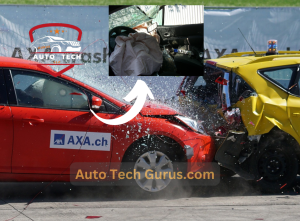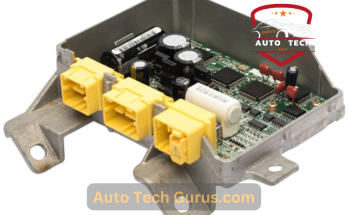Hey, fellow drivers! Have you ever been in a scenario where airbags didn’t deploy following an accident with your front bumper? It’s a troubling situation that could cause you to think about the reason for this vital safety feature’s failure. Let’s look into the possible reasons that resulted in the airbags not activating upon collision and shed light on the mystery of this problem.
Key Takeaways
1. Impact Severity and Sensor Functionality: The severity of the impact and sensor functionality is critical in airbag deployment.
2. Vehicle Age and Maintenance: Regular maintenance is crucial to prevent the deterioration of airbag components.
3. Electrical System Malfunction: Promptly address any electrical faults that could interfere with airbag deployment.
4. Software or Calibration Errors: Regular updates and calibration checks are essential for precise airbag deployment.
5. Manufacturer Recalls and Safety Defects: Stay informed about recalls and safety notices to address issues promptly.
6. Driver’s Role: Practicing defensive driving and maintaining safe distances can minimize collision risks.
Understanding the Mechanics: Why Airbags Did Not Deploy on Front Bumper Hit
You’re on the road when suddenly, the front bumper hits the vehicle and jolts it. After the incident, you find that your airbags didn’t work, leaving you with an uneasy feeling and anxiety. What is the cause of this vital safety device malfunctioning in the event of an accident?
Impact Severity and Sensor Functionality: Key Factors in Airbag Deployment
In the case of airbag deployment, the degree of collision plays a significant role. In certain instances, the frontal collision might not be sufficient to trigger the airbags. It is necessary to trigger the airbags, particularly when the impact isn’t enough force. In addition, the operation of the sensors that are responsible for the detection of the impact is critical. Any failure in the sensors could result in the airbags not being deployed and leave you exposed should you be involved in a crash.
Vehicle Age and Maintenance: Impact on Airbag Deployment
The condition and age of your vehicle are important factors that affect your airbag deployment. As time passes, the parts that enable airbag deployment could become damaged, which could lead to problems with the system. Regularly checking and maintaining the safety features in your car, which include an airbag, is crucial to ensuring that they function properly in the event of a crash.

Electrical System Malfunction: A Potential Culprit in Airbag Deployment Issues
In a few instances, an electrical system failure can hinder an airbag’s deployment if the airbag controller module does not work properly. The intricate wiring and sensors that allow an airbag to work could be weakened due to electrical issues, resulting in the airbag not being deployed when it is most needed. The quick resolution of any electrical issues is essential to ensuring the reliability of your car’s security features.
Software or Calibration Errors: Impact on Airbag Deployment Precision
The calibration and software that the airbag systems use are crucial for ensuring a perfect airbag deployment during a collision. The software’s errors or the measurement of the equipment could result in inaccurate airbag deployment, leading the system to fail when required. Regular calibration and software updates are vital to maintain the performance of your car’s airbag system.
Manufacturer Recalls and Safety Defects: Vigilance in Vehicle Safety
In certain instances, manufacturer recalls and safety problems could result in problems with airbag deployment. It’s important to keep informed of any recalls or safety warnings pertaining to your vehicle since taking action quickly to address these issues is essential to warranting the best performance of your car’s safety features.
The Human Element: Your Role in Ensuring Airbag Deployment
As the driver, your part in ensuring the proper deployment of airbags can’t be overemphasized. Maintaining a safe and secure following distance, adhering to speed limits, and ensuring you are practicing defensive driving is essential in reducing the chance of accidents, and also ensuring your car’s safety features like airbags perform as they were intended to when an unexpected happens.
Conclusion
The inability of airbags to activate after a car collision can be due to a myriad of factors that could cause the problem, which range from the severity of impact and sensor function to the age of the vehicle, maintenance issues, electrical system malfunctions, calibration issues, software issues, and recalls by manufacturers. As a responsible motorist, keeping yourself informed of these potential issues and making proactive efforts to resolve any issues that may arise with your car’s airbag system is essential to taking care of safety while driving.
When we are navigating the maze of car safety, it is crucial to understand how important it is to maintain the security of our vehicle’s features, which include airbags. By being aware, active, and alert, each of us can help warrant a safer and more enjoyable road trip for everyone. For the next time, enjoy safe travels!
Frequently Asked Questions
Q: Can a minor front bumper hit cause the airbags not to deploy?
A: Yes, the severity of the impact is a crucial factor in airbag deployment. In some cases, a minor front bumper hit may not meet the threshold required to trigger the airbags, leading to their non-deployment.
Q: How often should I have my vehicle’s airbag system inspected?
It’s recommended to have your vehicle’s airbag system inspected during routine maintenance checks or whenever you notice any indicators of potential malfunctions, such as dashboard warning lights related to the airbag system.
Q: What should I do if my airbags do not deploy after a collision?
If your airbags did not deploy after a collision, it’s essential to seek professional assistance to assess the integrity of your vehicle’s airbag system. Addressing any potential issues promptly is crucial to ensuring the safety of your vehicle.
Q: Can I drive my vehicle if the airbags do not deploy after a front bumper hit?
It’s not advisable to continue driving your vehicle if the airbags do not deploy after a front bumper hit. Seeking professional inspection and potential repairs should be a priority before resuming driving.
Q: How can I stay informed about manufacturer recalls and safety notices related to my vehicle?
Staying informed about manufacturer recalls and safety notices can be accomplished by regularly checking the manufacturer’s website, subscribing to notifications, and ensuring that your contact information is up-to-date with the vehicle manufacturer or authorized dealerships.
Q: Are there any specific driving practices that can help minimize the likelihood of airbag deployment issues?
A: Practicing defensive driving, maintaining a safe following distance, adhering to speed limits, and staying attentive on the road are all crucial in minimizing the likelihood of collisions and potential issues with airbag deployment.
Q: What steps can I take to ensure the proper functioning of my vehicle’s airbag system?
Regular maintenance, prompt resolution of any dashboard warning lights related to the airbag system, and seeking professional assistance for any potential issues are essential steps in ensuring the proper functioning of your vehicle’s airbag system.



